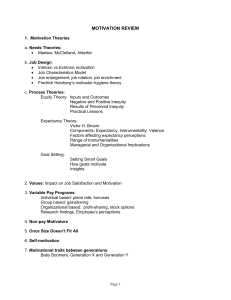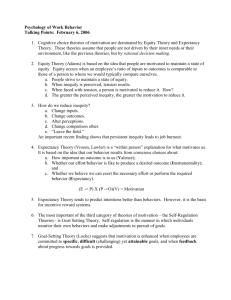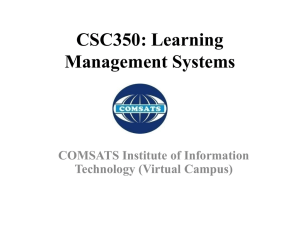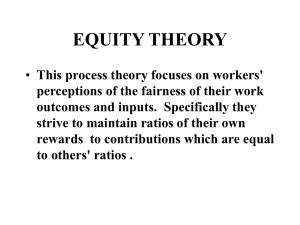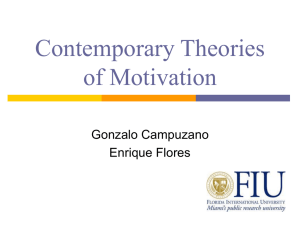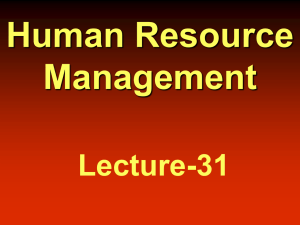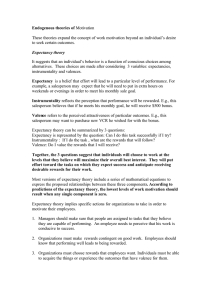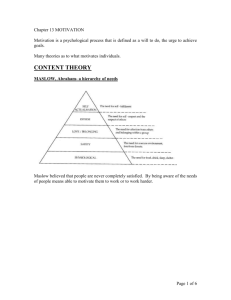CHAPTER 4
advertisement
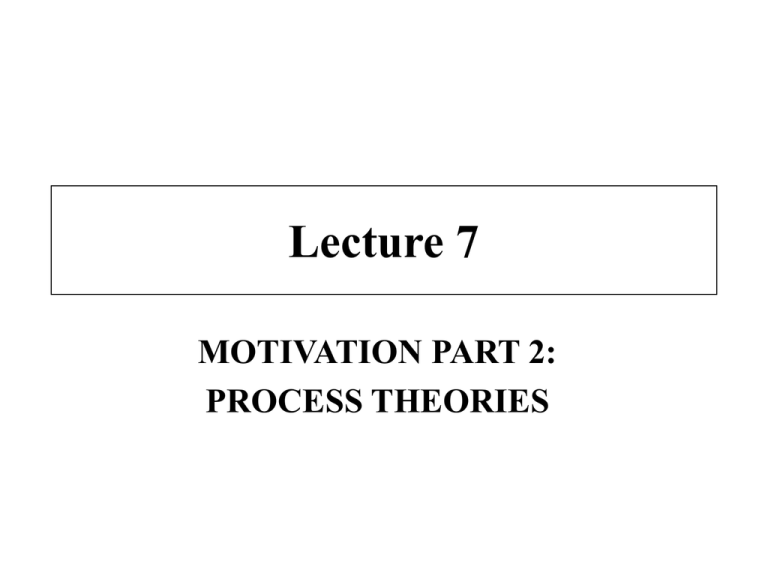
Lecture 7 MOTIVATION PART 2: PROCESS THEORIES Class Overview • Lecture - process theories of motivation – expectancy theory – equity theory – Porter-Lawler integrated model • Group exercise: Critical Incident “Salary versus Commission” Introduction • Why process theories? • These theories focus upon those internal processes that give rise to goal directed behavior • They highlight the importance of stimulus conditions (rewards) and personal expectations Expectancy Theory • Explains workers motivation in terms of anticipated rewards • the psychological force on an employee to exert effort is a function of two factors: – Expectancies in future – Attractiveness of specific outcomes Expectancy & Valence • Expectancies - probabilities ranging from zero to one: – Effort Performance • What is the probability that my effort will result in successful performance? – Performance Outcome • Will my good performance result in my obtaining the outcome or reward? • Attractiveness of outcomes are evaluated in terms of their their valence (from -1 to +1) Expectancy Theory (cont.) • Motivation can be quantitatively expressed in this theory by assigning a probability “score” to each type of employee expectation • Motivation can be expressed as: (P) x (PO) x (V) = Motivational Force Simple Example • • • • • Task: racing an Indy Car My Effort-Performance expectancy: 0.5 My Performance-Outcome expectancy: 1.0 My valence for winning +1.0 Total motivational force = 0.5 * 1.0 * 1.0 = 0.5 • John Andretti’s Effort Performance expectancy = 0.9 • His total motivational force = 0.9 Implications of Expectancy Theory • Employees must perceive a close link between effort and performance – requires careful selection, training, and job design • Employees must perceive a close and consistent link between rewards and performance – requires careful compensation design and administration, performance review, and communications Equity Theory • Primary assumption: people compare their situation to that of relevant others • Specifically, we compare our efforts and our rewards with those of others • Equity theory proposes that people will strive to restore equity if they feel an imbalance exists • It is this desire to restore equity that is the cause of goal directed behavior Effort and Rewards • Inputs: All contributions that a person makes to the employment relationship – effort, years and type of education, prior experience, training • Outcomes: Anything provided by an employee’s job – e.g. pay, benefits, working conditions, company car Comparisons • Comparison other: The person with which an individual compares his/her inputs and outcomes – typical relevant others: coworkers, boss, subordinates, professional peers, friends : Os : Is Oo : Io Example 1 • I work 8 hours a day and produce 50 widgets • My coworker Rob also produces 50 widgets in the same period • We both receive $500 a week, but Rob gets to use the company car on weekends • Equity? Example 2 • Rob and I both work 5 days every week • We both get paid the same $500 • I have a PhD, but Rob has a Bachelor’s degree • Equity? Behavior under Inequity • Under inequity we can try to change: – our behavior, our outcomes, others behavior, others outcomes • Lower ratio status - employee feels undercompensated: – Increase outcomes by asking for raise – Decrease inputs by being less productive – Decrease comparison other’s outcomes by persuading boss to alter B’s pay – Increase B’s inputs by pressuring him/her to work harder Behavior under Inequity • Higher ratio status - employee feels overcompensated – decrease outcomes? Unlikely – increase others outcomes? Difficult – decrease others inputs? Possible, but easier to... – increase own inputs. What typically will occur is that over paid employees may increase the quality of their output relative to more equitably paid workers Behavior under Inequity • If inequity can’t be rectified, then the individual may choose to pursue any of the following options: – Alter perceptions of situation to make inequity disappear – Select a different comparison other – Leave the work setting by getting a new job Porter-Lawler’s Model of Motivation • Integrates both content and process theories into one interactive model • Content theories: discuss what motivates people to perform; e.g. theories of Maslow, Herzberg, and McClelland • Process theories: discuss how rewards control behavior; e.g. expectancy, equity, reinforcement, social learning theories Conclusions of Porter-Lawler’s Model • A checklist for managers to use in motivating employees; managers should: – Offer valued rewards – Create perceptions that effort will lead to rewards – Design jobs so that effort leads to high performance – Hire qualified employees Conclusions of Porter-Lawler’s Model (cont.) – Train employees in the correct manner for performing their task – Design tasks so that performance is measurable – Design reward systems so that rewards are tied to performance – Ensure that rewards are viewed as fair and equitable Group Exercise • Critical incident “Salary versus Commission” (pp. 88-89) • Individually read the incident • As a group, discuss the three questions and write down your answers • I will call on you, so be prepared to defend your answers
